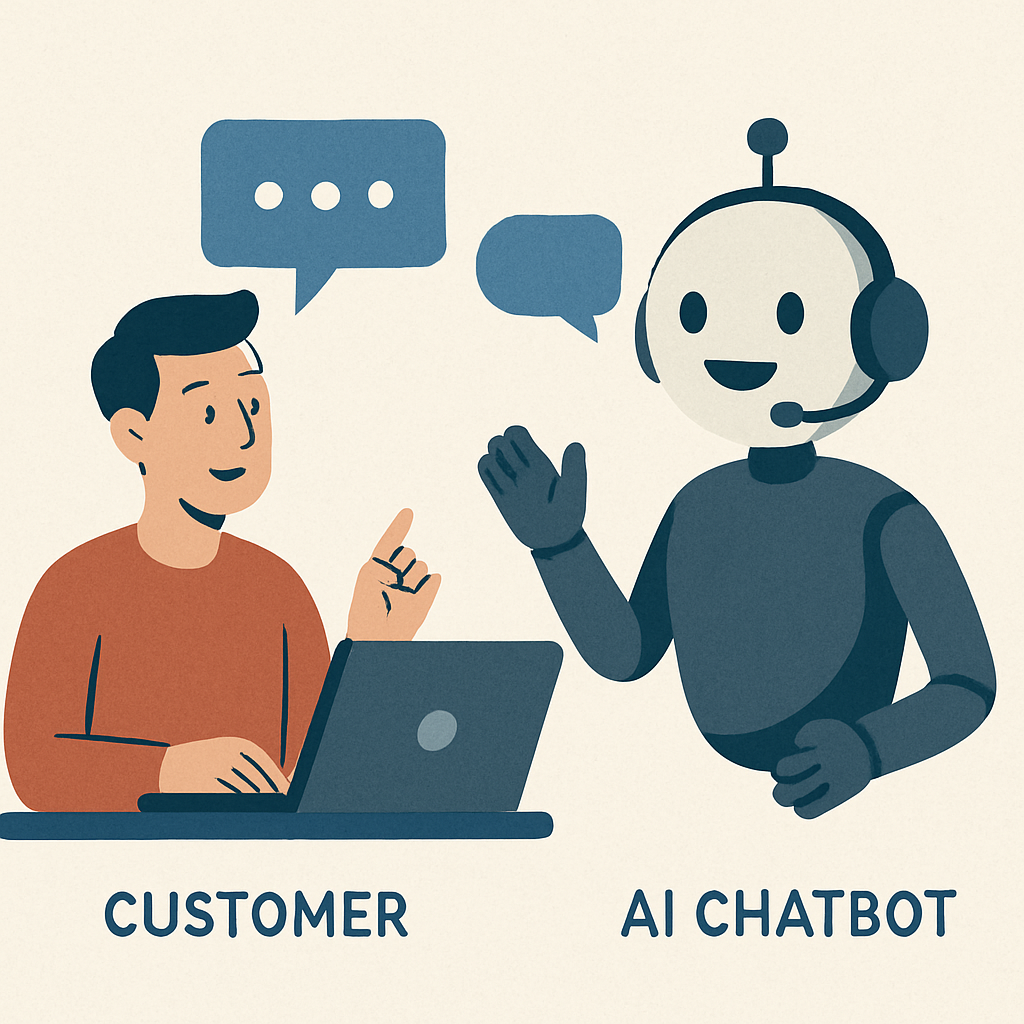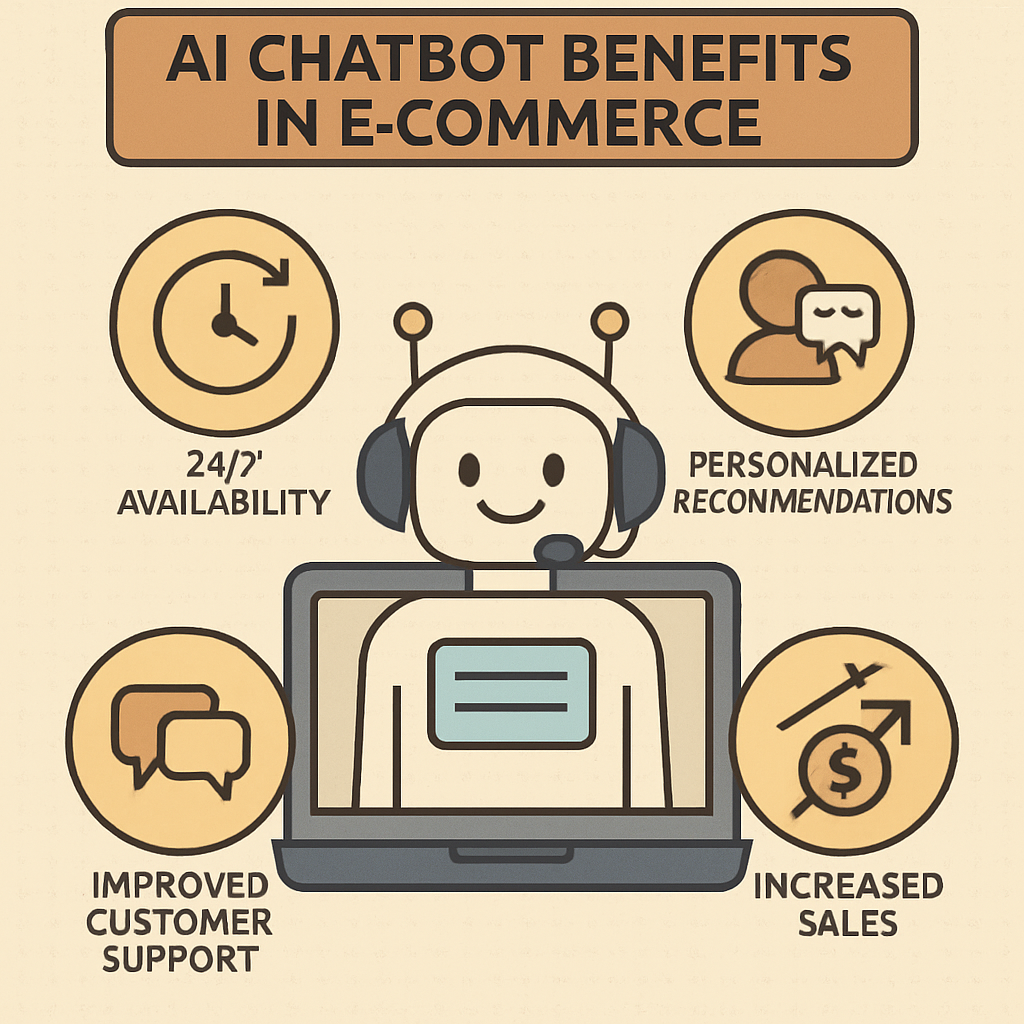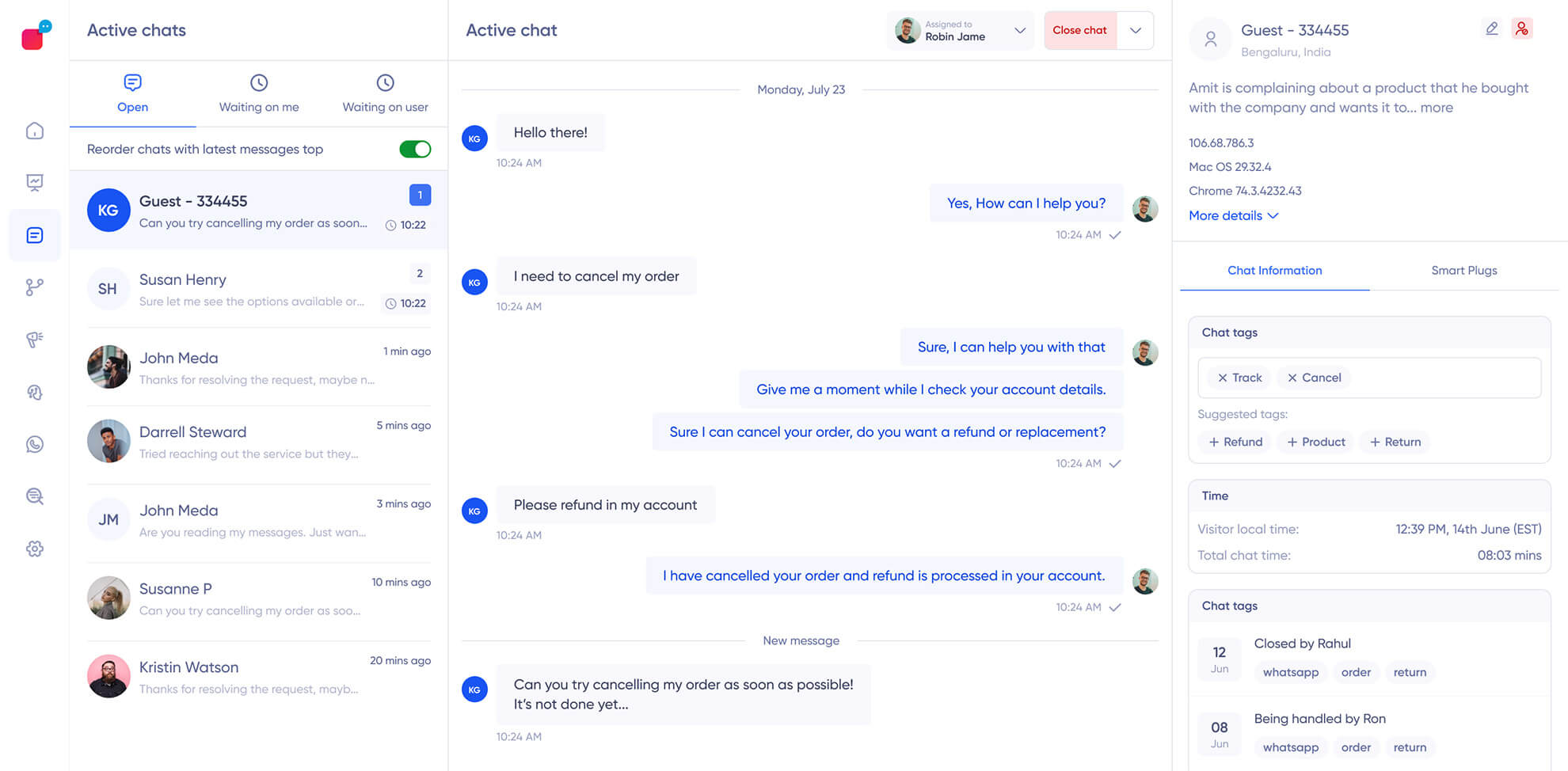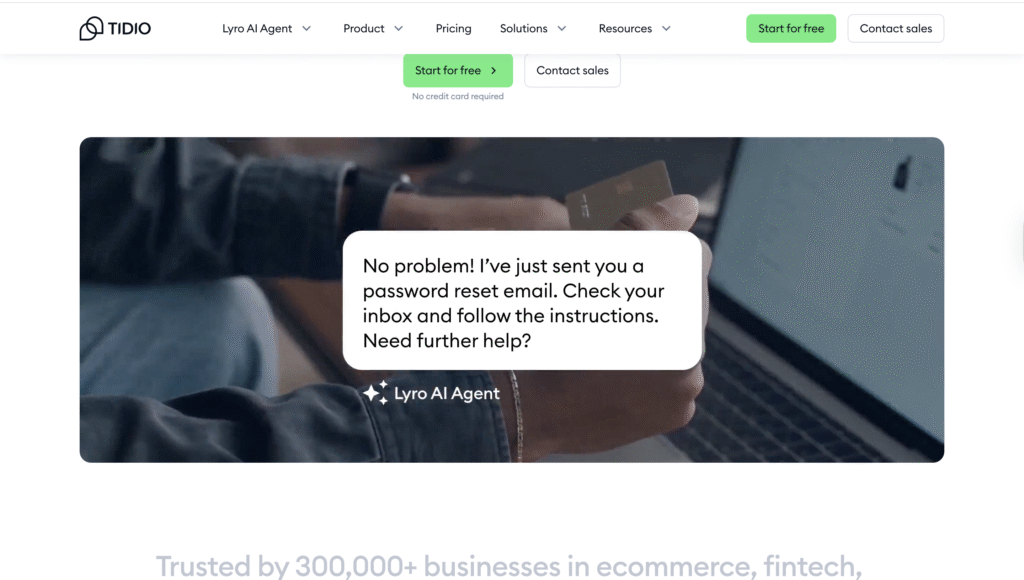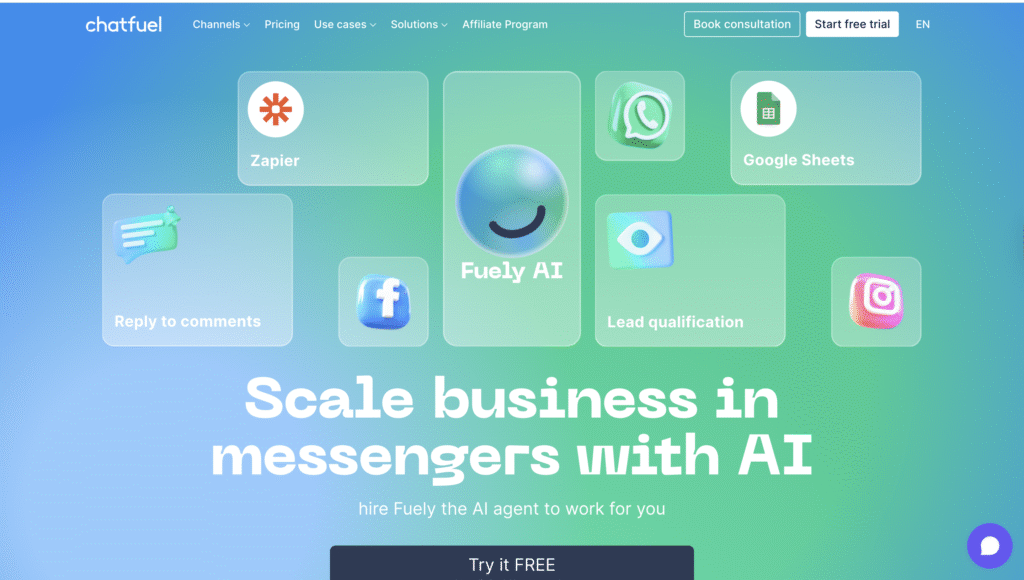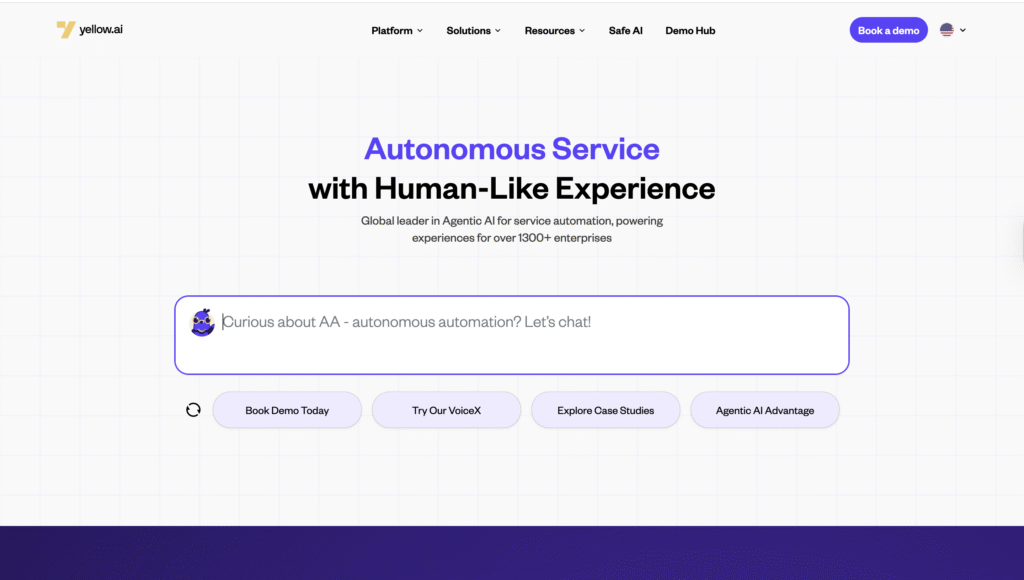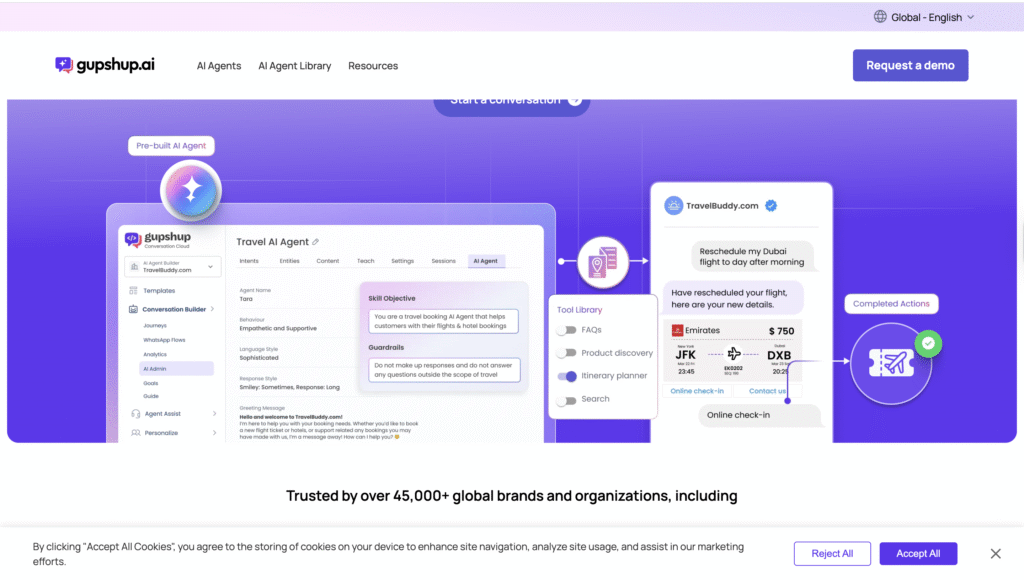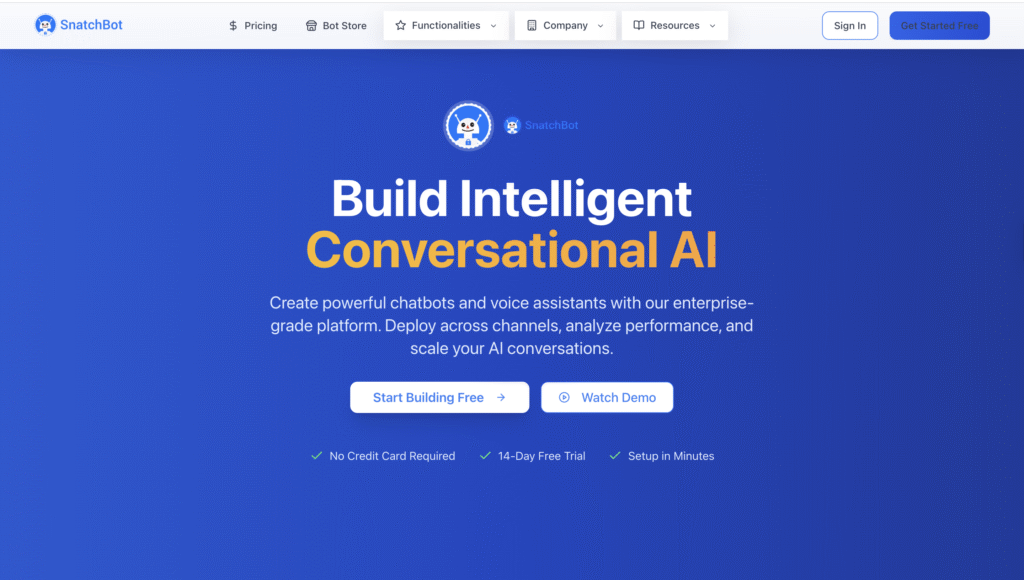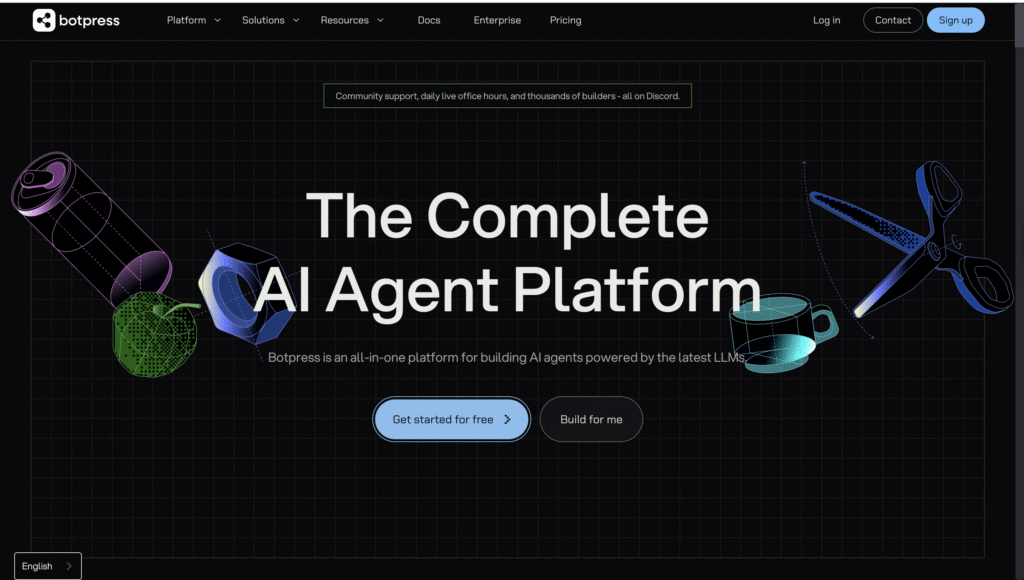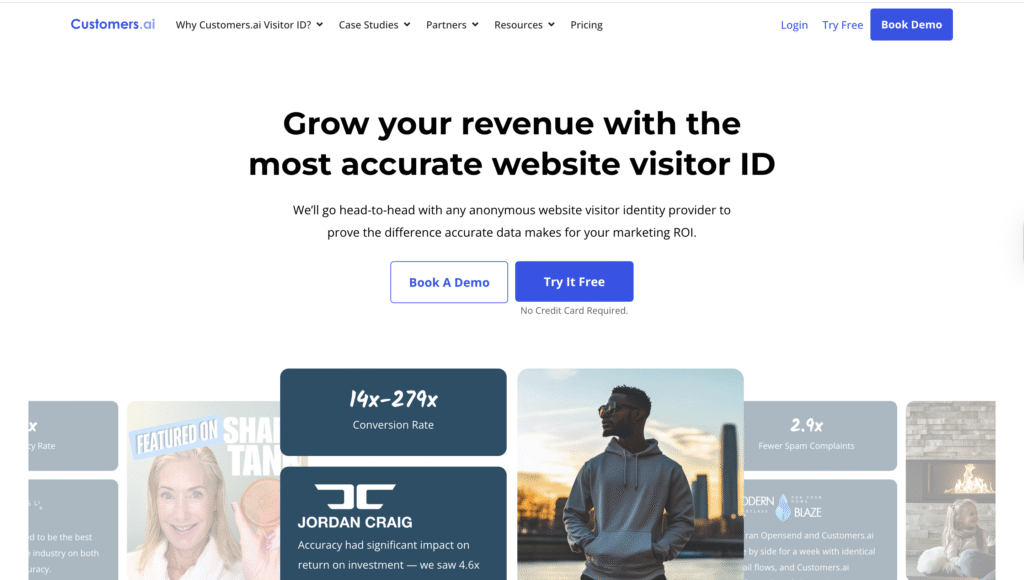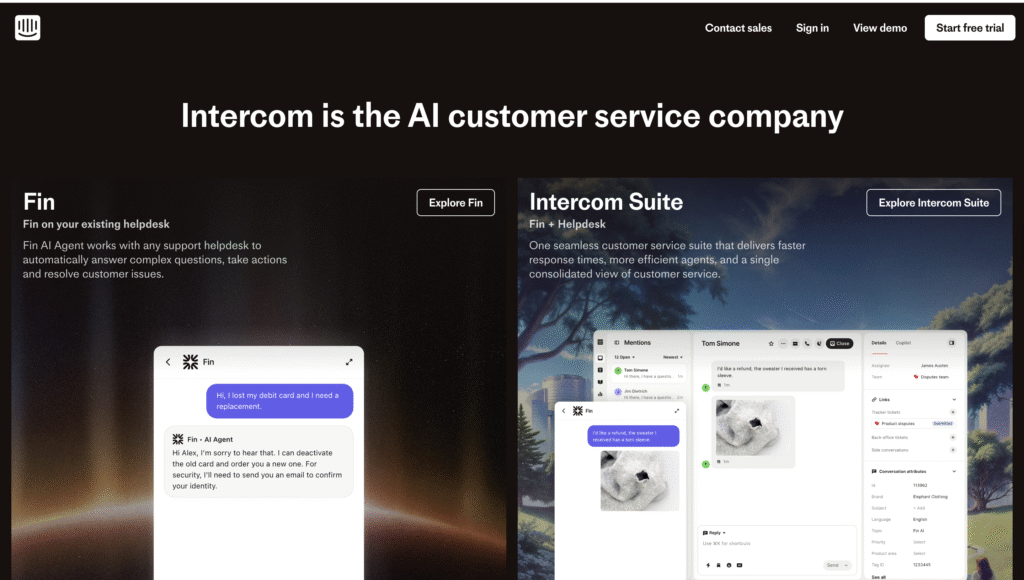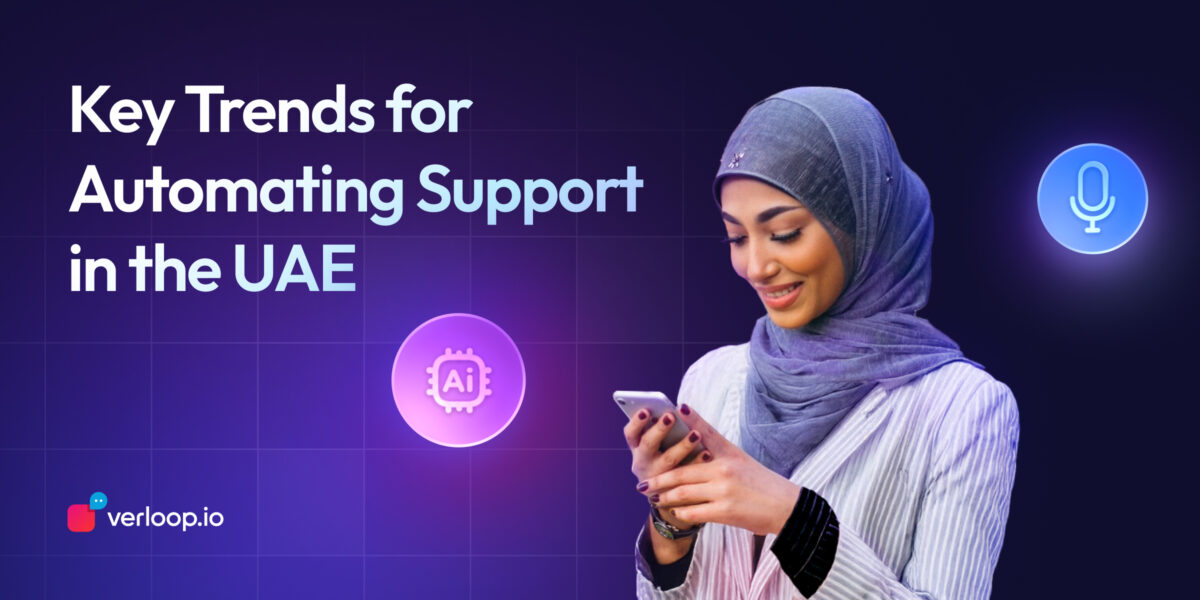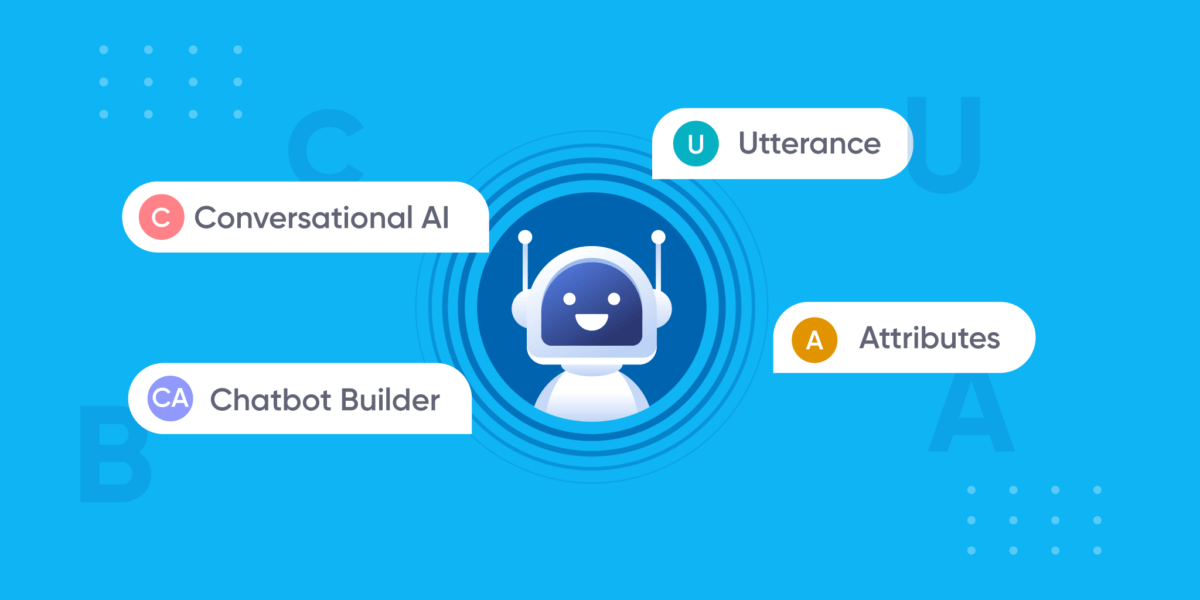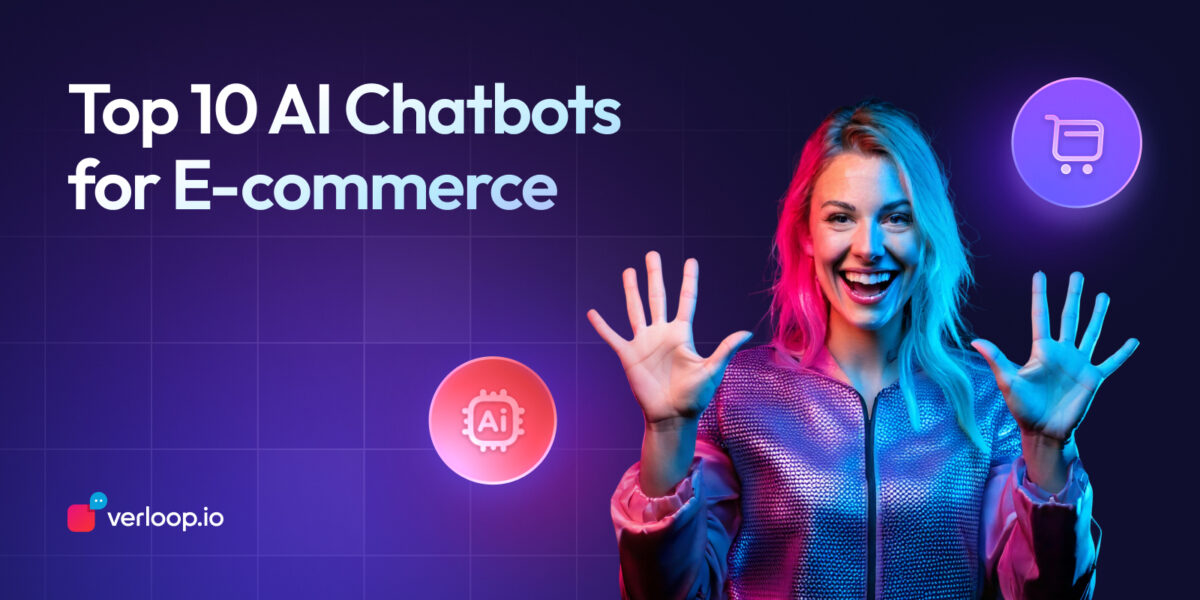
Top 10 AI Chatbots for E-commerce
- July 17th, 2025 / 5 Mins read
-
 Aarti Nair
Aarti Nair
Top 10 AI Chatbots for E-commerce
Shopping has changed. It’s no longer about just browsing and buying. It’s about being understood, assisted, and remembered. In a world where attention spans are shrinking and expectations are soaring, e-commerce brands are turning to AI-powered chatbots to deliver personalised, real-time conversations at scale.
And the numbers say it all.
The global AI-enabled eCommerce market is valued at $8.65 billion in 2025, and it’s projected to grow to $22.60 billion by 2032, expanding at a CAGR of 14.60%. That’s not just steady growth, it’s a clear signal that businesses investing in AI today are setting themselves up for smarter, faster, and more profitable customer journeys tomorrow.
But let’s be honest, choosing the right chatbot isn’t easy.
With dozens of tools out there promising automation, personalisation, and omnichannel magic, it’s hard to know where to start. That’s why we’ve put together this list of the Top 10 AI Chatbots for E-commerce, to help you cut through the noise and find the right fit for your brand, your team, and most importantly, your customers.
What Are AI Chatbots for E-commerce?
AI chatbots are intelligent software programs. They’re designed to interact with users via natural language. In e-commerce, they act as virtual assistants for customers.
These chatbots are integrated into e-commerce platforms. They help automate various tasks, such as customer inquiries and order processing. This makes online shopping more efficient and seamless.
AI chatbots utilise advanced technologies like natural language processing (NLP) and generative AI. This enables them to understand and respond accurately. They simulate human-like conversations.
These are the key functions of AI chatbots in e-commerce:
- Providing customer support.
- Assisting with product recommendations.
- Facilitating order tracking.
- Managing returns and refunds.
With the integration of chatbots, retailers can provide real-time support. This helps in reducing customer wait times significantly. Additionally, they operate round-the-clock, offering support day and night. Many e-commerce platforms support chatbot solutions. They can be easily integrated with websites, mobile apps, and social media channels. This provides a cohesive customer experience across multiple touchpoints.
AI chatbots are changing how businesses interact with customers. They enable personalised shopping experiences, increasing engagement and satisfaction.
Benefits of Using AI Chatbots in E-commerce
As time has proved that AI chatbots bring numerous benefits to e-commerce businesses, just look at Amazon’s support bot available on their application or the Nykaa style recommendation application on WhatsApp. They enhance the shopping experience, driving higher customer satisfaction. Here are the key advantages these chatbots offer.
24/7 Customer Support
AI chatbots provide round-the-clock service, even on off days or when your agents are on holiday. Customers can receive assistance at any hour, enhancing convenience. This increases customer loyalty.
Efficiency and Speed
Customers expect a fast response, and a delay in response results in affecting customer experience. As per our observation with your customers, the first response time should be in seconds and not in hours or days. Chatbots can easily handle multiple inquiries simultaneously. They process requests faster than human agents. This reduces wait times significantly.
Cost Reduction
Implementing chatbots helps lower operational costs by more than 40%. As they can automate repetitive queries like return requests, tracking details and more, to reduce the need for large support teams. This saves businesses money.
Enhanced Customer Engagement
Using GenAI chatbots, you can create human-like conversation flows to enable interaction with customers in a personalised manner. Using conversation or customer interaction data to create tailored recommendations and messages. This creates meaningful customer interactions.
Improved Data Collection
Chatbots gather valuable customer insights. They analyse interactions to uncover trends and preferences. This helps businesses make data-driven decisions.
Some of the specific benefits of using data-driven AI chatbots include:
- Real-time order tracking.
- Personalised product recommendations.
- Automated response to FAQs.
- Seamless return and refund processing.
Chatbots can also help in cart recovery efforts. They engage customers who abandon carts, encouraging them to complete their purchase on their preferred platforms like WhatsApp, or even while conversing on the application. This improves conversion rates.
They streamline operations and boost customer satisfaction. Their role in e-commerce is indispensable, offering both immediate and long-term benefits.
How to Use AI Chatbots for E-commerce: Best Practices That Actually Work
So, you’ve picked your AI chatbot platform—great. But now comes the part that makes or breaks your investment: implementation.
You see, adding a chatbot to your website or WhatsApp isn’t enough. To really see the difference—in conversions, in CSAT, in reduced ticket load—you need to build it right. That means focusing less on shiny features and more on customer experience, scalability, and intent.
Let’s walk through a few principles that separate average chatbot deployments from the ones customers actually enjoy using.
Start with clear goals. Always.
Before diving into conversation flows and NLP engines, take a step back. What do you want the chatbot to do?
- Are you trying to reduce support volume by 30%
- Increase checkout completions?
- Automate COD confirmations?
When your objectives are clear, every decision—from script tone to channel strategy—becomes easier and more aligned. Without goals, your bot’s just…talking.
Design it for humans, not machines.
Just because it’s powered by AI doesn’t mean it has to sound robotic. User experience should be the core of your design process. That means:
Clear, concise messages
Natural conversational flow
Buttons where they make sense
Options for handover to a live agent when needed
Remember: A smooth chatbot experience keeps customers engaged and reduces drop-offs. A clunky one?
They bounce—and maybe don’t come back.
Let NLP do the heavy lifting.
If your chatbot can’t understand what users are saying (even with typos or slang), it’s not going to be helpful. This is where Natural Language Processing (NLP) becomes your best friend.
By training your bot to recognise intent—“Where’s my order?”, “Do you have this in blue?”, “Cancel it please” You make the experience feel less like filling a form and more like having a conversation.
Go where your customers are.
Your customers aren’t only on your website. They’re also on WhatsApp, Instagram, Facebook Messenger, and even inside your mobile app. A truly effective e-commerce chatbot is one that supports multichannel engagement and maintains context across those touchpoints.
Pro tip: WhatsApp + web is a great starting combo for most retail and D2C brands.
Don’t set and forget.
Your chatbot is not a “launch it and leave it” tool. Like any digital product, it needs monitoring, tweaking, and updates based on:
Customer feedback
Chat drop-offs or misroutes
New product launches or policies
Look at it this way: your chatbot is like a new team member. Train it regularly, and it’ll only get better over time.
Personalisation is the secret weapon.
Generic bots are forgettable. But bots that greet customers by name, recall past orders, or suggest complementary products based on shopping history? That’s when the magic happens.
Use CRM and behavioural data to personalise product suggestions, offer relevant upsells, or even adjust the tone of conversation. Personalisation makes the chatbot feel like it actually knows the shopper, and that’s powerful.
Quick Checklist for Chatbot Success
Define your target audience and primary use cases
Align bot functionality with real customer needs
Keep the scripting simple, helpful, and natural
Test across all devices and channels before going live
Common Mistakes to Avoid while Adopting for E-commerce
Ignoring customer feedback or complaints about the bot
Overloading the chatbot with too many complex tasks
Skipping out on data privacy and security safeguards
Forgetting to optimise the bot post-launch
At the end of the day, a chatbot isn’t just another support tool—it’s part of your brand voice. Build it well, train it regularly, and keep it human-centred, and it’ll do more than handle queries. It’ll sell, support, and strengthen your customer relationships.

What Makes a Great E-commerce Chatbot?
Not all chatbots are created equal. Some simply automate FAQs. Others?
They act as intelligent salespeople that recommend products, answering questions, recovering abandoned carts, and even closing deals. As AI evolves into agentic systems and tools that don’t just assist but act on behalf of the customer. E-commerce businesses are starting to think bigger.
And they should.
According to recent research, while less than 1% of e-commerce brands currently use agentic AI, 33% are expected to do so by 2028. The shift is already underway. A staggering 93% of e-commerce businesses believe AI agents will give them a competitive edge, and with good reason.
Consumers are ready too. In fact, 70% say they’d use AI agents to purchase flights, and 65% would rely on them to book hotels and resorts.
So why not shopping carts and checkout pages?
When you consider that 10–30% of e-commerce revenue today comes from suggestive selling, the role of AI chatbots becomes even more strategic. AI agents that can recommend the right products at the right moment, based on real-time behaviour and past purchases, aren’t just helpful but they’re revenue drivers.
So, what should you look for when choosing an AI chatbot for your e-commerce brand?
Here are a few non-negotiables:
- Natural Language Understanding (NLU): The bot should understand intent, not just keywords, especially in a multi-lingual market like the UAE or MENA.
- Product Recommendations: Suggest relevant items based on customer preferences, behaviour, and inventory.
- Multichannel Support: Your chatbot should work seamlessly across your website, WhatsApp, Instagram, and more.
- Cart Recovery and Conversion Flows: Automate reminders, resolve objections, and help complete purchases.
- Personalisation: Use past purchases, user profiles, and real-time behaviour to tailor every conversation.
- E-commerce Integrations: Connect easily with Shopify, Magento, WooCommerce, and other platforms.
- Analytics & Optimisation: Track metrics like conversion rate, drop-off points, and popular intents to continuously improve performance.
A great e-commerce chatbot can handle support as well as drive sales, reduces friction, and helps your customers shop smarter. And with the right one, you don’t just automate but you elevate your e-commerce business
Criteria for Selecting the Best Ecommerce Chatbot
There’s no shortage of AI chatbots on the market, but not all of them are built for the complexity and speed of e-commerce.
Whether you’re managing thousands of SKUs, recovering abandoned carts, or scaling personalised support across channels, the chatbot you choose should align with where your business is today—and where it’s headed.
So how do you cut through the noise and make the right choice?
Let’s break it down.
Start with your business needs—before features
Do you need a chatbot to just handle basic FAQs? Or should it be capable of tracking orders, sending proactive WhatsApp messages, and supporting multiple languages?
Maybe you’re operating in a bilingual market like the UAE or Southeast Asia. Or perhaps your support team is struggling to manage high ticket volumes.
By clearly identifying your goals—be it deflection, conversion, or engagement—you can focus on platforms that solve those specific problems, not just the ones with the flashiest dashboards.
Integration is everything
Your chatbot shouldn’t feel like a separate tool—it should feel like part of your tech stack.
Look for platforms that integrate natively with your e-commerce platforms (like Shopify, WooCommerce, Magento), CRMs, payment systems, and analytics tools. A well-integrated chatbot means less manual work, better data flow, and a smoother customer journey from chat to checkout.
Make sure it speaks your brand
Your chatbot is often the first touchpoint a customer has with your brand. It should sound like you, not like every other generic bot out there.
That’s why customisation matters. Whether it’s naming your bot, setting its tone, or defining how it responds to queries, choose a platform that lets you personalise everything from script flow to visual appearance.
Generative AI takes this a step further. With tools that allow you to define bot personas, generate conversational flows from prompts, and dynamically adjust tone based on context, you can now create bots that truly reflect your brand’s personality—at scale.
Think long-term: scalability matters
What works for your 100-orders-a-day store might not hold up at 10,000.
Choose a chatbot platform that can grow with you—one that handles increasing query volume, adds new channels as you scale, and evolves in features without requiring a complete overhaul.
Look for Gen AI-powered tools like agent assist (Co-pilot), automated QA, or Smart Builders that reduce future effort while increasing efficiency as you expand.
Key features to look for:
Natural Language Processing (NLP) for more human-like conversations
24/7 availability across chat, WhatsApp, and voice channels
Advanced analytics and reporting to track CSAT, resolution time, and conversion impact
Generative AI capabilities such as prompt-based flow builders, bot persona customisation, and contextual replies
Multilingual support, especially if you’re targeting markets like MENA or Southeast Asia
Real-time CRM and order system integrations for personalised support
When chosen thoughtfully, your chatbot won’t just answer questions—it’ll become a revenue-generating asset and a key part of your customer experience strategy.
Because in e-commerce, the right conversation at the right time isn’t just nice—it’s non-negotiable.
Top 10 AI Chatbots for E-commerce
Choosing the right chatbot can transform your e-commerce site. We’ve compiled a list of the top 10 AI chatbots to guide you. Evaluate each one to find the best fit for your business needs.
The List of AI Chatbots for ecommerce:
- Verloop.io
- Tidio
- Chatfuel
- Yellow.ai
- Gupshup
- Ada
- SnatchBot
- Botpress
- Customers.ai
- Intercom
Explore these options to enhance customer experiences and automate your operations. Let’s dive into what each offers.
1. Verloop.io
Verloop.io is a leading Conversational AI platform designed to help e-commerce businesses automate customer support while delivering personalised, multilingual experiences across channels like Web, WhatsApp, Instagram, Messenger, and in-app chat.
Built using Machine Learning (ML), Automated Speech Recognition (ASR), and Natural Language Processing (NLP), Verloop.io enables end-to-end automation—ranging from AI-driven self-service to real-time agent support and quality assurance analytics.
It powers over 600 million customer conversations for 5,000+ businesses globally and supports 80+ languages, including regional dialects such as Arabic, making it ideal for brands operating in the UAE, MENA, and multilingual markets.
Features of Verloop.io
Verloop.io combines chat and voice automation with a strong generative AI foundation. Its feature set caters to both customer-facing automation and internal agent enablement:
- Multichannel support across Web, WhatsApp, Instagram, Messenger, and app
- Voice AI with speech normalisation, speech profiles, and on-platform testing
- Generative AI tools:
- Co-pilot for Support – an AI assistant that recommends replies and fetches context for agents
- Smart Block Prompt Builder – to create bot flows using simple prompts
- Bot Persona Customisation – define tone and behaviour for tailored interactions
- Real-time product recommendations, order tracking, and automated cart recovery
- In-house ML engine to resolve FAQs intelligently
- Live agent handover with access to historical chat and performance metrics
- Automated QA insights with metrics like CSAT, DSAT, chat count, and resolution timelines
- 99.9% uptime for enterprise-grade reliability
- Canned responses and CRM integrations for efficiency and personalisation
Pros and Cons of Verloop.io
Pros:
- User-friendly dashboard and easy implementation
- Powerful automation across chat and voice
- Seamless WhatsApp and e-commerce integrations
- Multilingual NLP with strong Arabic support
- Helpful analytics for tracking FRT, CSAT, and agent performance
- Scalable for both startups and enterprise use
- Excellent customer support and onboarding experience
What users are saying:
“It’s very smooth—we handle multiple customer chats at once.”
“We manage all pre-sales and post-sales engagement in one place.”
“Smart automation and ease of use. Just works well.”
“Great for WhatsApp support and handling high volumes of queries.”
Cons:
- Some users noted the lack of real-time notifications for new chats (especially across tabs).
- A few minor bugs and feature improvements requested for smoother agent experience.
- First response time (FRT) reporting accuracy could be improved in some cases
Pricing
Verloop.io offers custom pricing based on your support volume, number of channels, and feature modules.
- WhatsApp, Voice AI, and Co-pilot are available as modular.
- Tailored plans available for mid to enterprise-level e-commerce brands.
2. Tidio
If you’re looking for a platform that brings together live chat, automation, helpdesk support, and conversational AI, Tidio fits the bill.
Tidio helps e-commerce brands deliver real-time support, reduce missed chats, and scale customer service—without scaling the team. At the centre of it all is Lyro, Tidio’s conversational AI agent that can resolve up to 70% of common customer queries using your existing help content. With a no-code builder, multi-channel inbox, and tight integrations with Shopify and WooCommerce, Tidio is made for growing businesses.
Want to reduce abandoned carts, automate FAQs, and support customers on WhatsApp, Instagram, and Messenger—all from one dashboard?
Tidio has you covered.
Key Features
Live chat with GPT-4 assistant
Canned responses & typing preview
Visual chatbot automation builder (Flows)
AI assistant Lyro with multilingual support
Pre-built templates for e-commerce
Cart preview & order management
Ticketing system with prioritisation
Unified inbox across web, email, social, and WhatsApp
Chat analytics & team performance tracking
Shopify, WooCommerce, Klaviyo integrations
Pros & Cons of Tidio
What users love:
“Super intuitive and easy to manage even for a small team.”
“We love that Lyro works right away with our help docs.”
“Perfect for automating FAQs and managing chats 24/7.”
“The mobile app and analytics dashboard are excellent.”
What users flag:
“AI is promising, but still basic for complex questions.”
“Some advanced features only come in the higher plans.”
“Integration bugs occasionally need manual fixes.”
Pricing
Free – includes 50 Lyro AI conversations/month
Starter – from $24.17/month
Growth – from $49.17/month
Plus – from $749/month
You can start for free with no credit card required.
3. Chatfuel
Chatfuel is a messaging automation platform designed to enhance customer communication across social media and websites. With over 7 million users—including major names like Adidas, Netflix, and VISA—it helps businesses improve lead generation, automate FAQs, and drive sales.
Features
Multichannel support: WhatsApp, Facebook Messenger, Instagram
Real-time auto-replies in DMs and comments
Abandoned cart reminders and product updates
Drag-and-drop chatbot builder with zero coding
Built-in ChatGPT for advanced conversations
A/B testing, segmentation, and analytics
Integrations with Google Sheets, Shopify, Stripe, HubSpot, and CRMs
Pros
Easy setup and intuitive design—no coding required
Strong automation for FAQs and lead qualification
Fast, 24/7 customer support with <5-minute response time
Wide variety of ready-to-use templates
Official Meta partner, ensuring secure integrations
Cons
Pricing can escalate unexpectedly due to auto-scaling based on conversation volume
Some features may require developer support to unlock full functionality
Limited visibility on billing unless autoscaling is manually disabled
Pricing
Free Trial: 7 days, no card required
Facebook/Instagram Support: From $11.99/month
WhatsApp Support: From $35.00/month
Pricing varies based on volume and feature usage; autoscaling applies
4. Yellow.ai
Yellow.ai is a generative AI-powered customer service automation platform built to drive fully autonomous support for global enterprises. Its mission is clear: reduce operational costs while enhancing customer engagement through intelligent automation. With a presence in over 85 countries and support for 135+ languages, Yellow.ai serves 1100+ enterprise clients including brands like Sony, Hyundai, Lulu Group, Domino’s, and Logitech.
The platform is powered by a multi-LLM architecture, trained on over 16 billion conversations annually. This enables Yellow.ai to understand nuanced customer interactions, support real-time responses, and create seamless experiences across channels. It also offers Generative AI tools like a no-code bot builder, speech recognition, and natural language processing, making it ideal for brands seeking scale with personalisation.
Features of Yellow.ai
Gen AI-powered no-code bot builder
Multilingual support (135+ languages)
Voice and text automation
WhatsApp, website, and mobile integrations
Advanced NLP & ML engine
Custom workflows and campaign management
Analytics and reporting
Integrations with CRM and business tools
Smart appointment booking and transactional messaging
Speech profiles and speech normalisation
Usage-based pricing for enterprise scalability
Pros and Cons of Yellow.ai
Pros
- Highly scalable and multilingual.
- Excellent automation features, including transactional WhatsApp flows.
- Gen AI tools with robust NLP and voice automation.
- Designed for global enterprise needsWide range of integrations with third-party tools.
Cons
- Long implementation timelines as reported by some users.
- Poor communication and support follow-ups cited by a few businesses.
- High learning curve for first-time users
- .Enterprise plans can be expensive for small teams
- Limited analytical depth for non-enterprise users.
What users say
“Yellow.ai’s no-code interface made it really easy for our team to build dynamic chat flows. The chatbot supports 24/7 communication and integrates seamlessly with our CRM tools.”
– G2 Review
“While the platform is technically sound, our implementation experience has been disappointing with consistent delays and poor communication.”
– G2 Review
“It’s helped us lower customer support costs significantly and supports appointment booking and WhatsApp messaging all in one place.”
– G2 Review
Pricing
Free Plan: Limited to 1000 records/month and 1 active campaign.
Enterprise Plan: Unlimited usage, templates, and campaigns with usage-based pricing (contact for quote)
5. Gupshup
Gupshup is a conversation cloud platform that automates marketing, commerce, and support across 30+ channels including WhatsApp, SMS, Instagram, and voice. Trusted by 45,000+ brands globally—including Flipkart, Citibank, Netflix, and Khan Academy—it delivers over 10 billion messages monthly and supports everything from transactional alerts to flash-sale notifications at scale.
With a strong API layer and bot-building capabilities, Gupshup helps businesses consolidate fragmented communications into a unified, responsive channel—ideal for enterprises looking to modernise their customer engagement while maintaining high-volume reliability.
Features of Gupshup
30+ channels including SMS, WhatsApp, RCS, Voice
Unified messaging API for web, mobile, and social
Automated chat flows with bot support
Lead gathering and targeting tools
Live chat and sequencing AI
Personalised campaign templates and broadcast
CRM integrations, analytics, and segmentation
Voice assistants and customer profiles
Support for flash sales and high-volume traffic
Pay-as-you-go message pricing
WhatsApp Business API with media handling
Pros and Cons of Gupshup
Pros
- Reliable during high-volume events like flash sales.
- Robust API and multichannel messaging support.
- Strong automation for both support and promotions.
- Helpful account managers and industry best practices.
- Works well with SMS, WhatsApp, and newer RCS channels
Cons
- Steep learning curve for first-time users.
- Limited onboarding support and documentation.
- Some delays in customer support responsiveness.
- CRM integrations (like MoEngage or CleverTap) could be deeper.
- AI functionality is not as advanced as some competitors.
What users say
“Gupshup is our go-to for handling communication across WhatsApp and SMS. Even during flash sales, the platform is seamless and reliable.”
– G2 Review
“We’ve saved manual effort by automating common messages. Their API is strong, but new users may need a bit of time to learn it all.”
– G2 Review
“It’s helped us consolidate customer communication into one place and scale our campaigns without performance issues.”
– G2 Review
Pricing
Gupshup operates on a pay-as-you-go model.
Session Messages (India example):
$0.001/messageTemplate Messages (India example):
$0.0052/messageMedia surcharge (64KB–5MB):
+$0.001/message
There’s no fixed monthly plan—charges are deducted from a wallet balance based on usage, message type, and country.
6. Ada
Ada is a Canadian AI customer service platform focused on helping enterprises deliver extraordinary customer experiences at scale. Since its founding in 2016, Ada has powered over 5.5 billion automated interactions for companies like Square, Canva, YETI, and Monday.com, saving millions of hours in human effort.
More than just a chatbot, Ada positions itself as an AI transformation partner—blending agent management technology with strategic consulting to accelerate AI maturity for large businesses. Its core value lies in enabling rapid self-service while offering a branded, intuitive, and scalable customer experience.
Features of Ada
Self-Service Tools: Knowledge base, searchable articles, and community forums
Response Customisation: Route-to-human logic, drip sequences, and contextual menus
Platform Integrations: Zendesk (limited), live chat, analytics, A/B testing
Agent Console Features: Role-based access, branding controls, and dashboarding
Automation Design: AR-based flow refinement and customisable responses
Pros and Cons of Ada
Pros
- High containment rates for repetitive queries.
- Strategic support from Customer Success Managers.
- Collaborative user community via Ada Slack.
- Detailed analytics and weekly bot reports.
- Intuitive interface with no-code capabilities
Cons
- Heavy lift during implementation for complex intents.
- Integration limitations (e.g. no ZohoDesk support).
- Requires technical knowledge for advanced use cases.
- Some users report inconsistent onboarding experience.
- Basic formatting and dashboard customisation limitations
What users say
“Ada helped our small support team contain most ‘easy-to-resolve’ queries, giving agents space to focus on complex tickets.”
– G2 Review
“We love Ada’s openness to customer feedback—they actually listen and improve based on it. The support community on Slack is a bonus.”
– G2 Review
“Implementation was a bit of a challenge, especially with complex placeholders and APIs. But once set up, it really delivers.”
– G2 Review
Pricing
Ada offers custom pricing based on business needs.
No free trial
Enterprise packages tailored to size and volume
Pricing includes support, platform access, and integration features.
7. SnatchBot
SnatchBot is a no-code, AI-powered chatbot builder that helps businesses automate customer interactions across channels—web, mobile, and even voice. With an intuitive visual interface, SnatchBot allows anyone (not just developers) to design and deploy intelligent bots that understand context, handle multi-turn conversations, and deliver smooth customer experiences at scale.
Whether you’re running a small e-commerce site or scaling a digital storefront, SnatchBot simplifies chatbot creation—no coding, no fuss.
Key Features of SnatchBot
Drag-and-Drop Bot Builder: Easy visual interface with flow visualisation
Intelligent Conversational AI: Context-aware bots, NLP, smart replies
Voice AI Support: Speech-to-text, real-time voice interaction (available on Pro plans)
Omnichannel Deployment: Deploy bots on websites, mobile apps, messaging platforms
Advanced Analytics: In-depth conversation data and performance tracking
Enterprise-Grade Security: SOC 2 compliant, encrypted data handling
Pricing Plans
SnatchBot is one of the few chatbot platforms that offers a fully functional free plan, making it ideal for small businesses and solo entrepreneurs.
| Plan | Monthly Cost | Chatbots | Conversations/month | Voice AI | Branding | Support |
|---|---|---|---|---|---|---|
| Free | $0 | 1 | 500 | ❌ | SnatchBot | Community-only |
| Starter | $49 | 5 | 2,000 | ❌ | Custom | |
| Professional | $149 | 15 | 10,000 | ✅ | Custom | Priority |
Pros and Cons of SnatchBot
Pros
- Easy to set up and beginner-friendly.
- Great for e-commerce: supports payments, lead generation, and product queries.
- Visual builder requires no coding.
- Omnichannel and voice-ready on higher tiers.
- Affordable pricing with generous free plan
Cons
- Voice and advanced integrations only available on Pro plans.
- Community support only for free users.
- Some users find initial UI confusing.
- Limited payment integration options (mostly PayPal)
What users say
“My first SnatchBot was for ecommerce payments. With just a few flows and some email automation, I started generating inbound leads—without spamming anyone.”
– G2 Review
“As a free user, I wish there was better direct support. But once I got the hang of it, building bots became second nature.”
– G2 Review
“It’s been a game-changer for cart abandonment and Facebook engagement. The analytics alone are worth the price.”
– G2 Review
Best for
- Small to mid-sized e-commerce businesses.
- Brands looking for a cost-effective omnichannel solution.
- Teams with limited dev resources.
8. Botpress
Botpress is a robust AI agent infrastructure platform based in Montreal, designed to help teams build, deploy, and scale AI agents—not just basic chatbots. With users in over 190 countries and a recent $25M Series B funding round, Botpress is emerging as a powerful platform for enterprise-grade conversational automation.
Its biggest differentiator? Agents built on Botpress can reason, access APIs, run code safely, and handle multi-turn conversations. Whether you’re automating customer support, internal tools, or backend workflows, Botpress provides the scaffolding needed to build sophisticated, production-ready AI systems.
Key Features
No-code & Pro-code Studio: Drag-and-drop interface for business users; SDKs and APIs for developers
Generative AI Capabilities: AI text generation, summarisation, and reasoning
Live Chat + Handoff Support: Built-in live chat, routing, and menu-driven flows
Analytics & A/B Testing: Optimise performance with user behaviour insights
Role-based Access & Branding: Ideal for large teams and white-labelled solutions
Scalable Infrastructure: Each agent runs in an isolated, stable environment
Tool Orchestration: Integrate with Make.com, Twilio, and other Gen AI tools seamlessly
Pricing Plans
Botpress uses a pay-as-you-go pricing model, with clear options for different stages of business growth.
| Plan | Monthly Cost | Best For |
|---|---|---|
| Free | $0 | Hobbyists & prototyping |
| Plus | $89 | Startups & solo founders |
| Team | $495 | Scaling product teams |
| Enterprise | Custom | High-scale enterprise use cases |
Pros and Cons of Botpress
Pros
- Powerful AI agent infrastructure—beyond basic chatbots.
- No-code studio for non-technical users + full developer control.
- Supports multi-turn reasoning and memory.
- Integration with almost any AI or automation tool.
- Thriving Discord community and detailed documentation
Cons
- Free-tier is quite limited.
- Processing can slow down in complex workflows.
- UI changes frequently—can be disruptive.
- Human support is limited outside Discord.
What users say
“I built a full SaaS product without touching a line of code. Botpress made that possible.”
– G2 Review
“Their GenAI integration is miles ahead of many platforms I’ve tried. Plus, I can plug in APIs, make.com, and even Twilio—without code.”
– G2 Review
“UI changes are frequent, but they’re mostly improvements. Just wish there were more live support options.”
– G2 Review
Best for:
- Startups and scaleups building custom agents.
- Tech-savvy teams or dev+biz hybrid teams.
- Businesses looking to go beyond chat into full agent-based workflows.
9. Customers.ai
If your e-commerce site is seeing plenty of visitors but struggling to turn them into paying customers, Customers.ai might just be your secret weapon. Unlike traditional chatbot platforms, Customers.ai focuses on identifying anonymous website visitors and reconnecting with them—through emails, ads, and smart retargeting campaigns.
It doesn’t just tell you someone visited. It tells you who—complete with names, emails, LinkedIn profiles, behavioural insights, and even ad engagement. With seamless CRM and ad tool integrations, it’s built for marketers who want data-backed decisions and a smoother sales funnel.
Key Features
Visitor Identification: Turn anonymous traffic into real leads with enriched profiles
Customer Journey Tracking: Understand where users go, what they view, and how they return
Email & Ad Retargeting: Automatically reconnect via Meta Ads, Google Ads, and email
Advanced Segmentation: Target high-intent audiences with personalised campaigns
CRM & ESP Integrations: Syncs with Salesforce, Klaviyo, SendGrid, and more
Real-Time Alerts & Syncing: Pushes leads into the right funnel without the manual legwork
Pricing Plans
Customers.ai offers a 7-day free trial, no credit card required.
| Plan | Starting Price | Best For |
|---|---|---|
| Email + Ad Marketers | $399/month + usage | Mid-large eCommerce brands |
| Advertiser Model | 2% of ad spend | High-volume ad accounts |
| Agency Partnership | Custom Pricing | Agencies managing multiple clients |
Pros and Cons of Customer.ai
Pros
- Real person-level lead data—not just company info.
- Automatic syncing with Salesforce and other CRMs.
- Great for retargeting in a post-cookie world.
- Helps shorten sales cycles with high-intent insights.
- Easy to set up and use—even for beginners.
Cons
- Facebook reporting is limited within the dashboard.
- Occasionally needs a manual refresh to restore features.
- High entry pricing might not suit small businesses.
What users say
“We’re not guessing anymore. We know who visited, what they did, and when to reach out.”
– G2 Review
“Our cold leads are warming up again, and sales reps are thrilled with the quality of handovers.”
– G2 Review
“It’s the opposite of cold calling. We now know exactly who’s ready to talk.”
– G2 Review
Best for:
- Ad-heavy eCommerce brands losing data due to Meta pixel restrictions.
- Marketing teams that want to align with sales through better lead qualification.
- Agencies looking to add retargeting superpowers to their campaigns.
10. Intercom
Intercom’s Fin isn’t just a chatbot — it’s a full-fledged AI agent engineered to resolve complex customer queries with context, accuracy, and empathy. Powered by the Fin AI Engine™, it does more than just respond to FAQs. It connects to your data sources, understands intent, and handles refunds, identity checks, and account updates—all while mimicking your best human agents’ tone and language.
It integrates seamlessly with major helpdesks like Zendesk, Salesforce, and HubSpot, or works natively within the Intercom Customer Service Suite—an AI-human hybrid platform designed for scale and smarter resolution.
Key Features
Multi-language, omnichannel support (chat, email, SMS, voice, social)
No-code training suite: Analyze, Train, Test, and Deploy in one workspace
AI Copilot for agents and automation for repetitive queries
Personalised responses based on multiple knowledge sources
Action-based capabilities: issue refunds, update accounts, verify identities
Built-in proactive messaging, ticketing workflows, and conversation summaries
Deep integrations with third-party tools and helpdesks
Pricing
| Plan | Starting Price | Best For |
|---|---|---|
| Fin with your current helpdesk | $0.99/resolution | Businesses already using other helpdesks |
| Fin with Intercom Helpdesk | $29/month/seat | Teams using Intercom suite |
| Copilot add-on | $35/month/user | Enhanced agent productivity |
| Proactive Support Plus add-on | $99+/month | Outbound and lifecycle messaging |
Pros and Cons of Intercom
Pros
- Exceptional resolution quality, even for complex queries.
- Fast to set up and intuitive to train with existing help docs.
- Works across languages and channels 24/7.
- Deep integration with major CRMs and helpdesks.
- Rich analytics and fine-tuning capabilities.
Cons
- Occasional hallucinations or inaccurate responses.
- CX scoring lacks visibility inside full conversations.
- Some users report Fin closing tickets too early or misclassifying issues.
- Billing may overstate resolution counts (when human intervention is needed)
What users say
“We’ve seen our resolution times drop significantly, and Fin’s answers often match our best agents.”
– G2 Review
“Setup was surprisingly smooth. With the right articles, Fin learns fast and responds naturally.”
– G2 Review
“Fin has helped us scale without expanding headcount—delivering consistent CX while human agents tackle higher-value issues.”
– G2 Review
Best for:
- SaaS, e-commerce, and enterprise teams dealing with high support volume.
- Businesses seeking fast setup and smart escalation workflows.
- Teams looking to blend human agents with AI for always-on support.
Feature Comparison Table for 5 Ecommerce Chatbots
| Chatbot | Multichannel Support | Personalisation Features | Cart Recovery | E-commerce Integrations | Free Plan Available |
|---|---|---|---|---|---|
| Verloop.io | ✅ WhatsApp, Web, In-app Chat | ✅ Context-aware, CRM-integrated | ✅ | ✅ Shopify, WooCommerce, Magento | ❌ Free trial only |
| Tidio | ✅ Live Chat, Messenger, IG | ✅ Product recommendations | ✅ | ✅ Shopify, Wix, BigCommerce | ✅ Yes |
| Botpress | ✅ Website, API integrations | ✅ Memory-based responses | ❌ | ✅ Custom backend/API integrations | ✅ Free + Pay-as-you-go |
| Customers.ai | ✅ Web, Email, Meta, SMS | ✅ Behaviour + identity-based | ✅ | ✅ Klaviyo, Salesforce, SendGrid, HighLevel | ✅ 7-day trial |
| Intercom (Fin) | ✅ Web, App, Email, SMS, Voice | ✅ Tone, intent, brand-style | ❌ | ✅ Shopify, HubSpot, Salesforce | ❌ Pay-per-resolution |
Finding Your Perfect AI Chatbot Match
Choosing the right AI chatbot for your e-commerce business isn’t just about ticking off feature checklists—it’s about aligning with your growth goals, customer needs, and tech stack.
If you’re a scaling brand looking for deep integrations, Verloop.io and Intercom (Fin) stand out for their enterprise-grade automation and AI capabilities. Tidio offers an excellent entry point for small to mid-sized businesses with a clean UI and solid Shopify integration. Botpress is ideal for technical teams wanting full control, while Customers.ai gives marketers the power to retarget, reconnect, and convert lost leads with precision.
No single chatbot fits all, but with the right tool, you’re not just responding to customers—you’re creating conversations that convert.
Pro Tip: Start with a trial, evaluate based on ease of use, and measure success by how well it drives engagement, reduces support load, and ultimately—boosts your bottom line.
FAQ: Ecommerce Chatbot
1. What is an AI chatbot for e-commerce?
An AI chatbot for e-commerce is a software application that uses artificial intelligence (AI), particularly natural language processing (NLP), to interact with customers via chat interfaces. It can answer queries, recommend products, track orders, and even handle returns—helping businesses improve service efficiency and customer satisfaction.
2. How does an AI chatbot differ from a rule-based chatbot?
Rule-based chatbots follow predefined scripts and workflows, offering limited flexibility. AI chatbots, on the other hand, can understand natural language, learn from interactions, and respond to a broader range of queries—making them more conversational and scalable.
3. Can AI chatbots really increase sales in e-commerce?
Yes. AI chatbots can guide users through the buying process, provide personalised product recommendations, and recover abandoned carts—resulting in higher conversion rates. In fact, e-commerce retailers attribute 10–30% of revenue to suggestive selling, which AI chatbots can power effectively.
4. What features should I look for in an e-commerce chatbot?
Look for features like:
Natural language understanding (NLU)
Seamless integration with platforms like Shopify or WooCommerce
Multilingual support
Order tracking
CRM and marketing tool integrations
Generative AI and autonomous agent capabilities
Human handoff and live chat support
5. Are AI chatbots suitable for small businesses?
Absolutely. Tools like Tidio, ManyChat, and Tars are affordable and easy to set up—making them ideal for SMEs. They offer pre-built templates and integrations that help small brands scale support without growing their teams.
6. How much do AI chatbots typically cost?
Pricing varies widely. Some tools like Tidio and Botpress offer freemium models, while others like Intercom or Customers.ai may charge based on usage, number of users, or ad spend. Plans can range from $0/month to $499+/month depending on features and scale. But for a more advance solutions, Verloop.io can help automate ecommerce processes.
7. Can AI chatbots handle complex customer queries?
Modern chatbots—especially agentic AI solutions like Verloop.io, Fin (Intercom) or Botpress—are designed to handle multi-step reasoning, fetch data from external systems, and perform actions like refunds or cancellations. They can resolve complex queries or route them to human agents when necessary.
8. Will AI chatbots replace human support agents?
Not entirely. AI chatbots are great at automating repetitive, high-volume tasks and FAQs. However, for emotional, sensitive, or highly complex issues, human agents are still essential. The best systems create a hybrid experience—using bots to triage and assist, and humans for personalised support.




